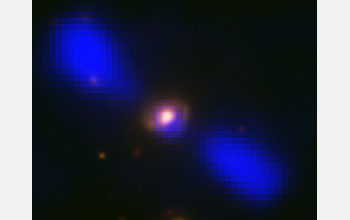Multimedia Gallery
Strange galaxy perplexes astronomers
A radio-optical overlay image of galaxy J1649+2635. Yellow is a visible-light image; blue is the radio image that indicated the presence of jets. J1649+2635 is only the fourth, jet-emitting spiral galaxy discovered thus far.
More about this image
In 2014, with the help of citizen scientists, a team of astronomers found an important new example of a very rare type of galaxy that may yield valuable insight on how galaxies developed in the early universe. The new discovery technique promises to give astronomers many more examples of this important and mysterious type of galaxy.
The galaxy, named J1649+2635, is nearly 800 million light-years from Earth and is a spiral galaxy -- like our own Milky Way -- but with prominent "jets" of subatomic particles propelled outward from its core at nearly the speed of light. The problem is that spiral galaxies are not supposed to have such large jets.
"The conventional wisdom is that such jets come only from elliptical galaxies that formed through the merger of spirals. We don’t know how spirals can have these large jets," said Minnie Mao of the National Radio Astronomy Observatory (NRAO).
J1649+2635 is only the fourth, jet-emitting spiral galaxy discovered thus far. "In order to figure out how these jets can be produced by the 'wrong' kind of galaxy, we realized we needed to find more of them," said Mao.
The astronomers examined large collections of images from both radio and optical telescopes and enlisted the hands-on assistance of volunteer citizen scientists. The citizen scientists were participants in an online project, called the Galaxy Zoo, in which they look at images from the visible-light Sloan Digital Sky Survey and classify the galaxies as spiral, elliptical or other types. Each galaxy image is inspected by multiple volunteers to ensure accuracy in the classification.
Next, the astronomers cross-matched the visible-light spirals with galaxies in a catalog that combines data from NRAO's VLA Sky Survey and the Faint Images of the Radio Sky at Twenty Centimeters survey, both done using the VLA. The cross-matching was done by Ryan Duffin, a University of Virginia undergraduate working as an NRAO summer student. Duffin’s cross-matching showed that J1649+2635 is both a spiral galaxy and has powerful twin radio jets.
"This is the first time that a galaxy was first identified as a spiral, then subsequently found to have large radio jets," said Duffin. "It was exciting to make such a rare find," he added.
NRAO is a facility of the National Science Foundation, operated under cooperative agreement by Associated Universities, Inc.
Read more about this research in the NSF News From the Field story Strange galaxy perplexes astronomers. (Date image taken: Unknown; date originally posted to NSF Multimedia Gallery: Feb. 7, 2017)
Credit: Mao et al., NRAO/AUI/NSF, Sloan Digital Sky Survey
Special Restrictions: Before using this image, please read NRAO's Image Use Policy.
Images and other media in the National Science Foundation Multimedia Gallery are available for use in print and electronic material by NSF employees, members of the media, university staff, teachers and the general public. All media in the gallery are intended for personal, educational and nonprofit/non-commercial use only.
Images credited to the National Science Foundation, a federal agency, are in the public domain. The images were created by employees of the United States Government as part of their official duties or prepared by contractors as "works for hire" for NSF. You may freely use NSF-credited images and, at your discretion, credit NSF with a "Courtesy: National Science Foundation" notation.
Additional information about general usage can be found in Conditions.
Also Available:
Download the high-resolution JPG version of the image. (85.2 KB)
Use your mouse to right-click (Mac users may need to Ctrl-click) the link above and choose the option that will save the file or target to your computer.

